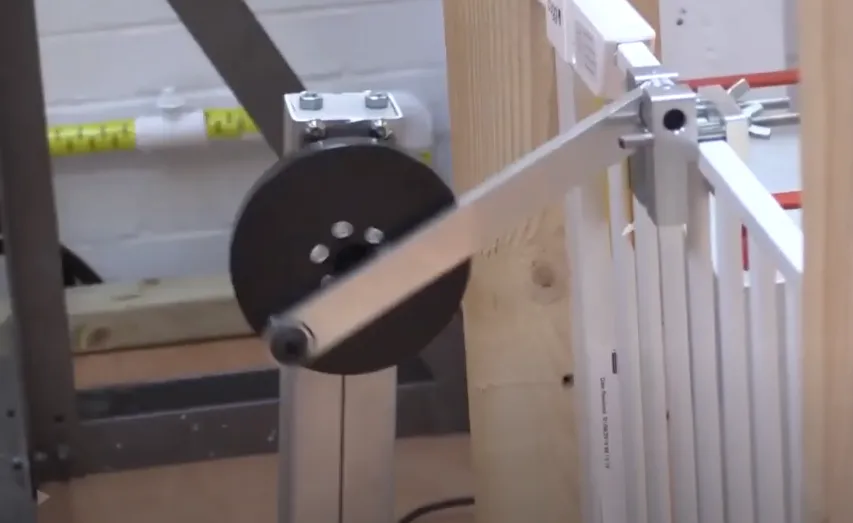BS EN 14988 Safety Requirements for Children’s High Chairs Testing
The British Standard (BS) and European Norm (EN) 14988 are internationally recognized standards that specify the safety requirements for children's high chairs. Compliance with these standards ensures that products meet rigorous safety criteria, protecting both manufacturers and consumers from potential hazards.
This standard covers various aspects of design, materials, construction, and performance to ensure high chairs are safe for use by infants and toddlers. The primary focus is on preventing injuries caused by falls or other mechanical failures. Some key areas include:
- Structural integrity
- Material safety
- Stability under load
- User interface design
- Labeling and instructions for use
The testing process outlined in BS EN 14988 involves multiple stages to ensure all relevant aspects are covered. Manufacturers must undergo a series of tests to verify that their high chairs meet the specified safety requirements.
Some common tests include:
- Fall prevention: Ensuring the chair does not tip over under normal use conditions.
- Mechanical strength testing: Evaluating how well components withstand stress without failure.
- Labeling and instructions verification: Confirming all necessary warnings and usage guidelines are provided clearly.
- Material safety checks: Screening for harmful substances that could leach into food during prolonged contact.
The standard also mandates regular inspections of high chairs, especially those used by infants who may be more vulnerable to accidents. Manufacturers must provide detailed documentation about these inspections and any necessary repairs or replacements.
Understanding the specific requirements under BS EN 14988 helps manufacturers design safer products that meet regulatory expectations. This ensures not only compliance with international standards but also enhances brand reputation through demonstrated commitment to child safety.
In summary, complying with BS EN 14988 involves thorough testing and stringent quality control measures aimed at reducing risks associated with children's furniture use. By adhering strictly to these guidelines, companies can produce safer products that instill confidence in parents while protecting their brand integrity.
Scope and Methodology
The scope of BS EN 14988 encompasses all aspects related to the safety design, construction, and performance evaluation of children's high chairs. Key areas include:
- Design considerations for preventing falls and other accidents.
- Selecting safe materials that do not pose health risks when in contact with food or beverages.
- Evaluating structural stability under various loading conditions.
- Ensuring proper assembly instructions are provided to facilitate easy, safe setup by parents or caregivers.
The methodology for conducting tests according to BS EN 14988 involves several steps. First, the high chair must be assembled exactly as instructed. Then, it undergoes a series of specific tests designed to simulate real-world usage scenarios:
- Static load testing: Applying defined weights to assess structural integrity.
- Fall simulation: Simulating accidental tipping by applying forces in different directions.
- Mechanical stress testing: Exerting controlled pressures on critical components like legs and supports.
- User interface assessment: Evaluating the ease of use for both parents and children.
Each test is conducted meticulously, with detailed records kept throughout. Compliance is determined by comparing results against predefined acceptance criteria set forth in the standard.
In addition to these mechanical tests, there are also chemical analysis requirements to ensure no harmful materials leach out during prolonged contact with food or drink. These analyses contribute significantly to overall product safety evaluation.
Eurolab Advantages
At Eurolab, we offer comprehensive testing services that go beyond mere compliance; they provide valuable insights into improving your products and establishing a strong market position. Here’s why choosing us for BS EN 14988 safety requirements testing is advantageous:
- Expertise in International Standards: Our team comprises industry experts who keep abreast of the latest developments in international standards like BS EN 14988.
- State-of-the-Art Facilities: Equipped with advanced instrumentation and equipment, our labs ensure precise measurements and accurate results.
- Comprehensive Reporting: Detailed reports provide not just pass/fail outcomes but also actionable recommendations for improvement.
- Quick Turnaround Time: We understand the importance of timely delivery; hence, we strive to complete tests efficiently without compromising quality.
- Cost-Effective Solutions: Our pricing structure is designed to offer cost-effective options that fit various budgets while maintaining high standards.
- Client-Centric Approach: Our services are tailored to meet individual client needs, ensuring optimal outcomes for each project.
- Regulatory Compliance: By adhering strictly to all relevant regulations and guidelines, we help you maintain a compliant product range.
Choosing Eurolab means leveraging our extensive experience in providing top-tier testing services. We ensure that every aspect of your high chair design meets stringent safety requirements, thereby enhancing consumer trust and satisfaction.
Competitive Advantage and Market Impact
- Innovation Leader: By staying ahead in terms of compliance with international standards like BS EN 14988, you can differentiate your brand as a leader in child safety.
- Enhanced Consumer Trust: Demonstrating adherence to stringent safety protocols builds credibility and fosters trust among potential buyers.
- Potential for Premium Pricing: Products that meet or exceed these standards often command premium prices due to perceived higher quality.
- Broad Global Appeal: Compliance with international standards makes it easier to penetrate global markets, especially those where stringent regulations apply.
- Increased Market Share: Superior safety features can attract more customers, leading to increased market share and profitability.
- Competitive Edge in Procurement: Suppliers who demonstrate compliance with such standards are often favored by major retailers and buyers worldwide.
These competitive advantages not only enhance your brand’s reputation but also contribute significantly to long-term business success. Ensuring that every product meets or exceeds the stringent requirements set forth in BS EN 14988 is crucial for maintaining a strong market presence.





